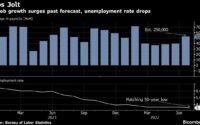Here’s the inflation breakdown for February 2024 — in one chart
Shoppers are seen in a Kroger supermarket in Atlanta on Oct. 14, 2022.
Elijah Nouvelage | AFP | Getty Images
Consumers continued to contend with higher inflation in February, according to new government data.
The consumer price index — an inflation measure that tracks changes in the prices of consumer goods and services over time — rose 3.2% from a year ago and 0.4% in February, according to monthly data released by the Bureau of Labor Statistics.
Inflation is down from its hottest point in 2022, but is still warm, considering the Federal Reserve’s 2% inflation target. While Americans’ optimism about the economy has improved, many still say that price increases have caused financial hardship, a recent Gallup poll round.
February’s monthly rise was mostly due to increases in gasoline and shelter, according to Mark Hamrick, senior economic analyst at Bankrate. Yet food prices overall were flat for the month.
While there has been progress bringing year-over-year headline and core inflation down, there could be some stalling of that progress in the near term, said David Doyle, head of economics at Macquarie, pointing to the spikes in gas and shelter.
“There is more room to fight on the inflation battle,” Doyle said. “And there’s a bit further to go before everyone goes out and declares victory.”
Where inflation was high in February
Certain items have seen double-digit increases in prices year over year, including juices and drinks, up 27.2%, and motor vehicle insurance, with 20.6%.
Drivers also contended with increased prices for motor vehicle repair, up 8.5% year over year. Meanwhile, though gas prices were down 4.2% year over year, they were up 4.1% for the month.
More from Personal Finance:
Why gas is so expensive in California
Credit card users face ‘consequences’ from falling behind
After Biden praises progress on inflation, economists weigh in
Certain consumer services, such as admissions to sporting events and tax return preparation, were up 11% and 9.8%, respectively.
Why Americans still feel financial strain
Inflation in the CPI has subsided since its 9.1% peak in 2022. Real wages are on the rise, said Hamrick, which means people are seeing wages adjusted for inflation.
Yet inflation has risen a total of 20% since before the pandemic, Hamrick said. So while those higher wages restore some of what was lost in purchasing power, it is not a full replacement, he said.
“There’s still this sense of having lost something, because purchasing power was truly lost in that transition,” Hamrick said.
One important gauge that shows the economy is strong — the unemployment rate — has been below 4% for the longest stretch since the 1960s, he said.
However, for those laid off as companies shed thousands of jobs in recent months, the employment market may not feel strong. Likewise, inflation may hit some people harder than others. Those experiences tend to shape how people feel about the economy, Hamrick said.
An upward inflection will not feel great for consumers, Doyle said, and also points to a longer time before the Federal Reserve starts to cut rates.
“That doesn’t mean that we’re still not in a disinflationary process,” Doyle said.
When interest rates may subside
One factor that affects how well Americans are doing — for better or for worse — is interest rates.
When it comes to savings, there’s the opportunity to get the highest returns on cash in years. But those with debts — such as credit cards or mortgages — are likely facing higher costs on those balances.
The Fed is expected to lower interest rates this year, after having executed a series of rate increases to try to tamp down inflation. But the central bank’s March meeting likely will be too soon for a cut.
“We don’t perceive there to be like an imminent pressure on the Fed to cut rates,” such as a recession or sudden rise in unemployment, Doyle said.

Before implementing any cuts, the Fed will want to have evidence that its work combatting inflation is done, he said.
“We’re sort of skeptical that over the next couple of months that the Fed will be able to get there,” Doyle said.
The first interest rate reduction may come in July, according to Macquarie’s forecast, with two cuts totaling 50 basis points this year. The firm is also predicting reductions totaling 50 basis points in 2025.
Rate cuts will help borrowers, especially those who are leaning more heavily on their credit cards now, Hamrick said.
[ad_2]
Source link


